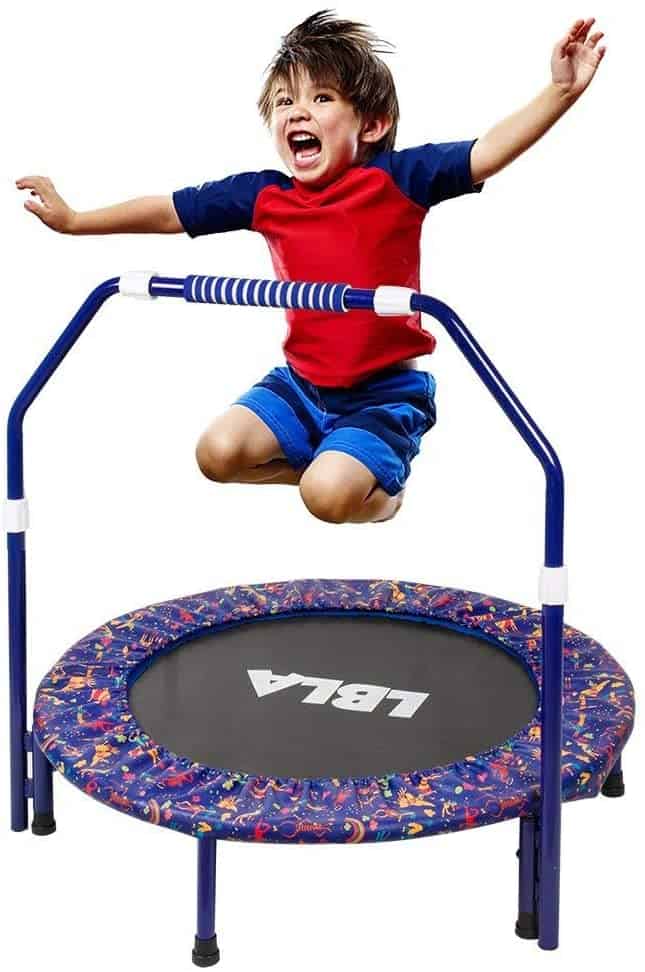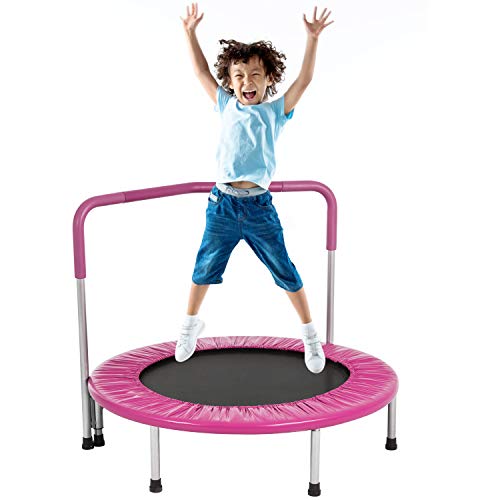Are Rebounders Safe For Toddlers?
Few things can be as enticing to a child as a bouncy surface in the home, especially if they see their parents or carers jumping up and down on it regularly!
But are rebounders safe for toddlers? Rebounders and mini-trampolines can be great for young kids, helping them develop motor and balancing skills, burn off energy, and keep fit. If you ensure the little ones are supervised properly, put some important safety measures in place, and are clear and consistent with them about what they can and can’t do, then there’s no reason a rebounder can’t be a fun, healthy addition to the family home.
There are undoubtedly safety issues to consider when it comes to rebounders and toddlers, though not necessarily ones that can not be appropriately addressed.
Today, we’ll take a look at some of the things you’ll want to consider when deciding whether or not a mini-trampoline is right for your child, and how to try to ensure that any rebounder in the home is as child friendly and safe as possible for your family.
Here is my recommendation on the safest and most durable rebounder for kids:
- ※【STURDY CONSTRUCTION FOR ULTIMATE SAFETY】:The trampoline Made of bold steel and coming with 6 legs for added support ,mini trampoline legs can properly thread to screw onto the base, this 36 inch kids trampoline guarantees the great stability. trampoline for kids 36 inch trampoline jumping mat trampoline.
- ※【THE TRAMPOLINE HANDRAIL TO KEEP BALANCE】: Trampoline handrail is wrapped in a high density sponge,The kids trampoline well-padded safety handrail ensures young children can grip well and jump with confidence, they are not lose their balance while jumping use the mini trampoline,trampoline with handrail effective protection of children’s safety. trampoline with handrail trampoline for kids mini trampoline.
- ※【STRONG SPRINGS CAN PROVIDE EFFECTIVE SPRING FORCE】: The springs of the trampoline have been tested, Each one is strong and durable for kids trampoline, strong spring and reliable jump cloth provide sufficient spring force for the mini trampoline.Children trampoline kids trampoline mini trampoline with handrail mat.
Last update on 2024-07-26 / Affiliate links / Images from Amazon Product Advertising API
Is a mini-trampoline safe for a 2 year old?
Let’s start with a few cautions before thinking about putting in safety measures, beginning with a question about much younger children. Is a mini-trampoline safe for a 2 year old? After all, there are plenty of rebounders out on the market specifically targeted for toddlers.
The short answer is ‘No, and certainly not without an adult by their side helping to hold them steady’. 2 year olds, regardless of how fast they may mature, are almost certainly not going to have developed the requisite strength, balance, and spatial awareness to be able to prevent themselves from toppling over, nor are they going to be able to keep themselves safe if they do so.
This could lead to them spraining or fracturing a limb, hitting their head, or generally harming their body if left even for a moment to navigate the unsteady, unfamiliar surface of a rebounder on their own.
If they are going to be allowed to stand on it as a fun, experimental piece of play then this needs to be with an adult helping to stabilise them.
Even with hand bars to help keep them upright, their limbs are unlikely to have developed the strength needed to withstand harder bounces and the other muscles of the body are unlikely to be able to keep them safely balanced.
Remember, most toddlers start to experiment with walking on flat ground between 6 and 18 months. This is still a very new skill for them by the time they reach the age of 2!
Introducing a bouncy, unpredictable surface, whilst it may seem fun, is also going to be difficult for them to get their head (and feet!) around without having an adult by their side to support them.
Is trampolining OK for toddlers?
An often reported piece of advice when it comes to trampolining and children is that any child under 6 should not be allowed on a rebounder due to the risks they pose.
It is not difficult to see why this advice might be shared – sprains, fractures, bruised limbs and, in the worst case scenarios, head or spinal injuries can all occur, particularly when numerous children are using a trampoline at the same time.

The advice to keep under 6’s away from trampolines appears to be led not only by anecdotal incidents and sometimes tragic personal stories but by the American Academy of Pediatrics’ own recommendations from roughly 10 years ago.
However, this advice commonly refers to larger trampolines, usually outdoor models, that are often used by other children simultaneously.
These trampolines come with a different set of risks to the smaller, mini-trampolines or rebounders that we are considering here, though there is some overlap in terms of the dangers they can pose to little ones.
Larger trampolines are often further off the ground, resulting in greater harm if children happen to misjudge their bounce and topple over the edge.
Crucially, children are also often encouraged by the size of larger trampolines to attempt flips, high jumps, or general acrobatics that they may not have the strength or skill to do safely.
Even well behaved and generally sensible kids are liable to do this, especially in the company of their peers. It’s just what kids do when given the space to have fun and experiment with what’s physically possible, or if they feel the need to show off!
Rebounders, or mini-trampolines, do not necessarily share all of these risks. They don’t tend to afford space for more than one child at a time – nor should you be permitting more than one child to use them simultaneously!
They are nearly always closer to the floor. Their small diameter means that, though the surface is still bouncy and potentially unstable for a child, acrobatics are implicitly discouraged.
Even the most adventurous toddler is less likely to attempt a backflip on a mini-trampoline than they are with a larger model outdoors, since it just isn’t likely to ‘feel safe’ in the same way a large trampoline can sometimes do.
Furthermore, hard-and-fast boundaries when it comes to what children should or should not be allowed to do at a specific age tend to overlook the fact that children, particularly between the ages of 1 and 6, develop at astonishingly varying rates.
What may be appropriate for one 4 and a half year old may not be appropriate for a 6 year old, depending on their own physical development, temperament, and situation.
That’s why parents, who know their kids best, should always make judgments based on what they know about their child’s behaviour and capabilities.
Toddlers can benefit in numerous ways from using a rebounder or mini-trampoline, if it’s done safely and supervised properly.
As well as helping to burn off some of your little one’s seemingly inexhaustible energy stores, the bouncy surface can also help them develop and hone their vestibular system.
This is the system, centred around the inner ear, which is linked to balance and poise.
Children can also boost their fine motor skills, spatial judgement, and understanding of their physical limits by using a mini-trampoline.
It would also appear to be self-evident that bouncing merrily along on the rebounder is going to be better for your child’s mood, circulation, digestion, and general fitness than sitting hunched over a tablet screen for hours on end!
Mini trampolines and toddlers – making them safe
With these benefits in mind, how can you go about trying to make sure your mini-trampoline is suitably safe for your family?
No amount of preparation is going to make any childhood activity involving exercise entirely risk free, and some bumps and knocks picked up along the way are just part of the journey of childhood!
Nevertheless, there are a range of things you can do to try to reduce the chance of your kids being hurt or seriously injured when they’re using the rebounder.
First and foremost, adult supervision is key. Even if you are not by their side to physically prevent them from falling, making sure you are in the same room and ready to attend to any accidents swiftly, as well as put a stop to any potentially dangerous behaviour as soon as it first appears, is crucial.
Children should understand that the rebounder is a fun but not entirely safe aspect of play-time and part of that understanding should be tied to the fact that they are not allowed to use it without adult supervision.
Keep the rebounder on soft ground. Thick carpet can be relatively safe, or you can buy additional padded mats to place around the area:
Make sure that all edges and handles are suitably padded as well. Any surface which could cause a cut or lead to a relatively hard impact should be covered over with foam or cushioning.
Assume that any exposed piece of material can and will at some point come into hard contact with your child and wrap it up accordingly.
Are Mini Trampolines Safe
Whether you are an adult ready to use your mini trampoline for the first time or looking out for a little one, mini trampolines are perfectly safe.
We would always recommend, if you are going to get your child a rebounder or mini-trampoline, then opting for one designed specifically for children or with child-focused safety features.
Adult rebounders, though they may look similar, often come with surfaces that are harder and less flexible, which can increase the distance a child may inadvertently jump, as well as being harsher on their limbs.
Furthermore, for younger children especially, some form of child friendly handrail should be used, so that they can hold on and support themselves as they develop the requisite motor and balance skills to bounce independently.
It’s also worth opting for a model which comes with a safety net around the outside.
If you have more than one little one in the house, make sure they’re not all using it simultaneously! Accidents occur most frequently when children are bouncing on trampolines together and heads knocking together can be just as harmful as heads hitting anything else in the room.
Make sure you keep the mini-trampoline in the main living area where everyone sits, rather than in your children’s bedrooms, to discourage it from being used outside of adult supervision.
When you’re not there to keep an eye on things and think that your child is unlikely to be able to resist having a go on it when you’re not around, pack it away or put it in a room away from the children.
An ex-triathlete, fitness coach and writer with a Masters in Sports Physiology. Fitness is my passion and I've had my fair share of home fitness equipment tried and tested!







One Comment